
由Archi-Tectonics设计的两座体育场馆已在杭州亚运公园封顶,使这个占地116英亩的综合体--这家总部位于纽约的建筑公司也进行了总体规划--接近完工。网球馆和曲棍球馆都有5000个座位,将成为一英里长的公园的主力,并承办2022年亚运会的比赛,这是继奥运会之后最大的国际多项目比赛。亚运会结束后,体育场和公园将适应新的用途,成为杭州城市标志性的公共休闲综合体。场地利用的规划从最初阶段就推动了公园和体育场馆的设计,在项目一开始,Archi-Tectonics就研究了遗留的公共项目方案,以确保综合体在未来几十年内仍然是一个活跃的城市生活中心,并设计了公园和建筑,以适应这些未来的用途。例如,网球桌体育场设计了一个混合座位系统,结合了体育场和露天剧场的座位风格,使其既能举办体育赛事,又能在奥运会后举办音乐会和其他表演。曲棍球场将被改造为夜市和露天音乐会等户外聚会。
Two stadiums designed by Archi-Tectonics have topped out at Hangzhou Asian Games Park, bringing the 116-acre complex—which the New York-based architecture firm also masterplanned—closer to completion. The Tennis Table and Field Hockey Stadiums—both 5,000 seats—will anchor the mile-long park and host competitions for the 2022 Asian Games, the largest international multi-sports competition after the Olympics. Once the Games end, the stadiums and park will adapt to new uses, becoming a signature public recreation complex for the city of Hangzhou.Planning for legacy use drove the design of the park and stadiums from the earliest stages. At the outset of the project, Archi-Tectonics studied legacy public programming options to ensure the complex remains an active center of urban life for decades to come, designing the park and buildings to easily accommodate these future uses. The Tennis Table Stadium, for example, is designed with a hybrid seating system that combines stadium and amphitheater seating styles, enabling it to host both sporting events and—after the Games—concerts and other performances. The Field Hockey Stadium will be adapted for outdoor gatherings like night markets and open-air concerts.
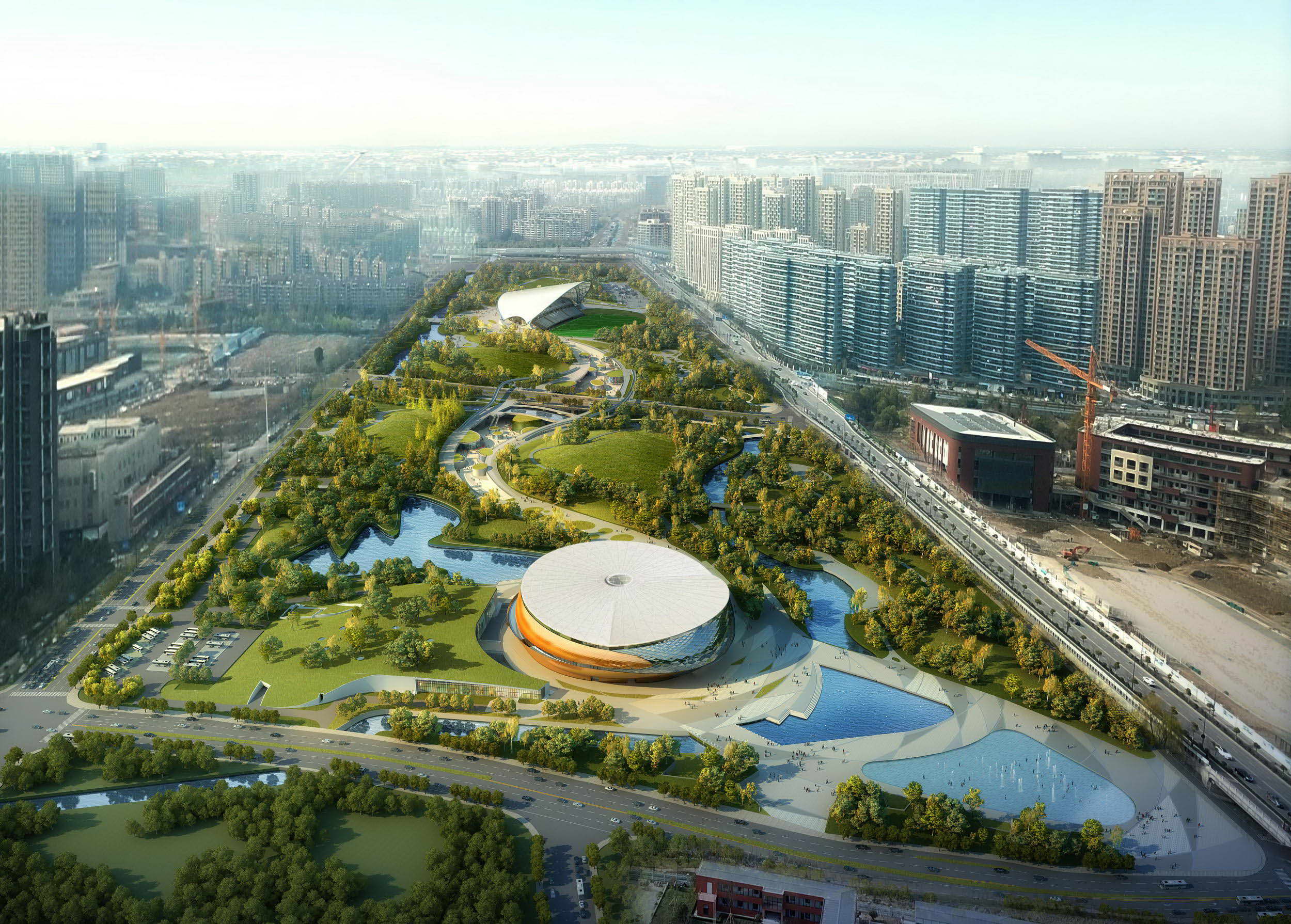
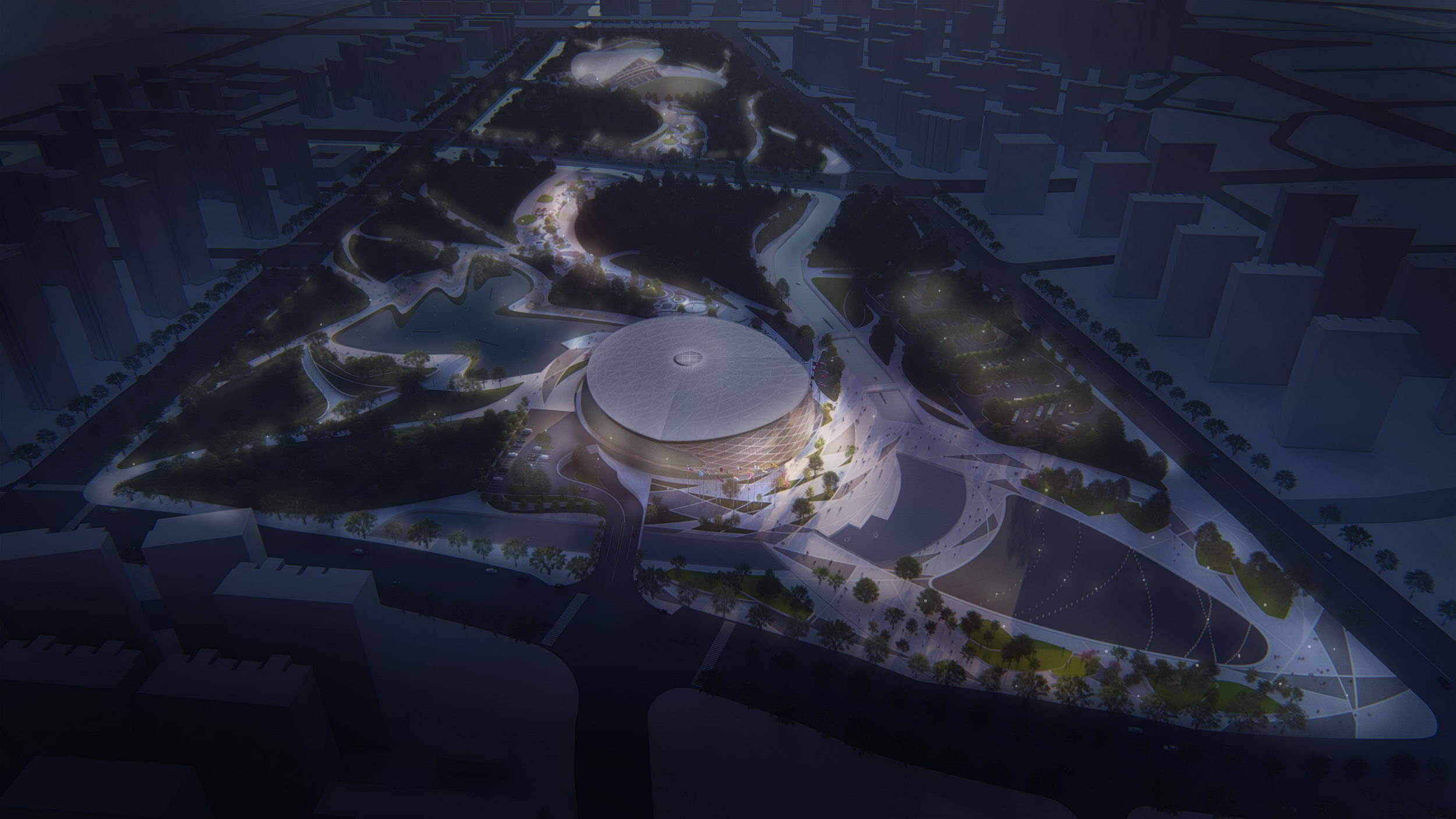
"如果没有对未来的规划,像这样的项目有可能成为“大白象”:闲置、维护成本高,而且会破坏城市的结构,"Archi-Tectonics的创始负责人Winka Dubbeldam说。"我们在规划亚运公园时,考虑到了杭州的未来,将其设计成附近日常生活的固定设施,支持城市的持续发展,并使城市更具可持续性和弹性。"该设计还包括支持这些传统用途所需的基础设施,使综合体能够在奥运会结束后无缝转换。虽然奥运会本身将完全由公共交通提供服务,但Archi-Tectonics谨慎地将64.5万平方英尺的停车空间纳入公园下方,支持遗产用途,包括体育场馆中的重大活动以及Village Valley购物中心的购物、自然步行和休闲体育联盟。此外,定制设计的太阳能翼为室外照明系统供电,使公园在夜间安全舒适地用于公共娱乐,而不会增加过多的碳排放。Archi-Tectonics在国际邀请设计竞赛中获胜后,获得了杭州亚运公园的委托。该公司与 !Melk景观设计公司和Thornton Tomasetti工程师合作开发了总体规划和设计。工程计划于2021年完成。
“Without a plan for the future, projects like this risk becoming white elephants—unused, expensive to maintain, and disruptive to a city’s fabric,” says Winka Dubbeldam, Founding Principal of Archi-Tectonics. “We planned Asian Games Park with Hangzhou’s future in mind, designing it to become a fixture of daily life in the neighborhood, support continued urban growth, and make for a more sustainable and resilient city.” The design also includes the infrastructure that will be required to support these legacy uses, enabling the complex to seamlessly convert after the Games end. Though the Games themselves will be serviced completely by public transit, Archi-Tectonics discretely incorporated 645,000-square-feet of parking space underneath the park, supporting legacy uses including major events in the stadiums as well as shopping in the Village Valley Mall, nature walks, and recreational sports leagues. More, custom-designed Solar Wings power an outdoor lighting system, allowing the park to be safely and comfortably used for public recreation at night without increasing its carbon footprint. Archi-Tectonics received the commission for Hangzhou Asian Games Park after winning an international invited design competition. The firm developed the masterplan and designs in collaboration with !Melk Landscape Design and Thornton Tomasetti Engineers. Construction is scheduled to complete in 2021.
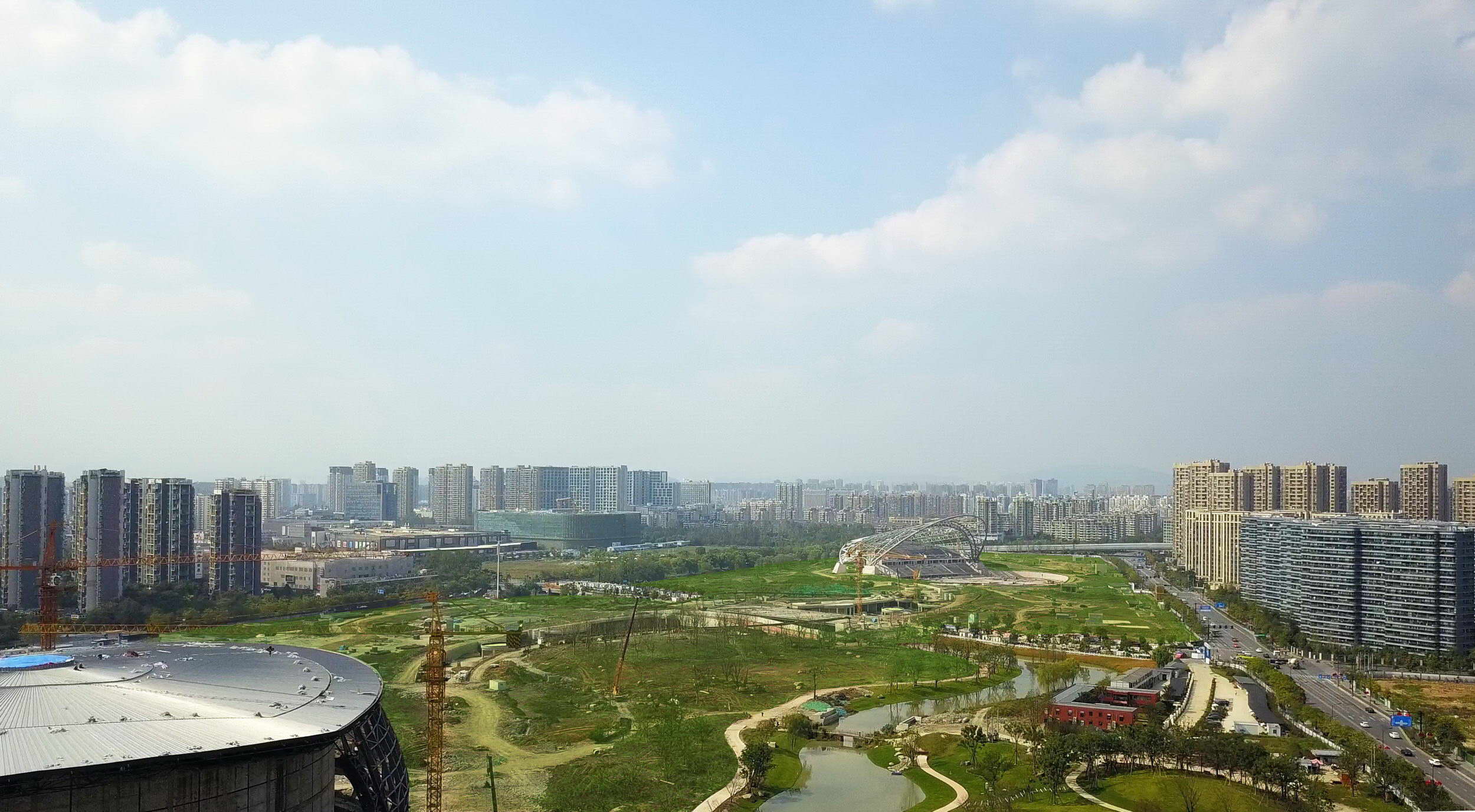
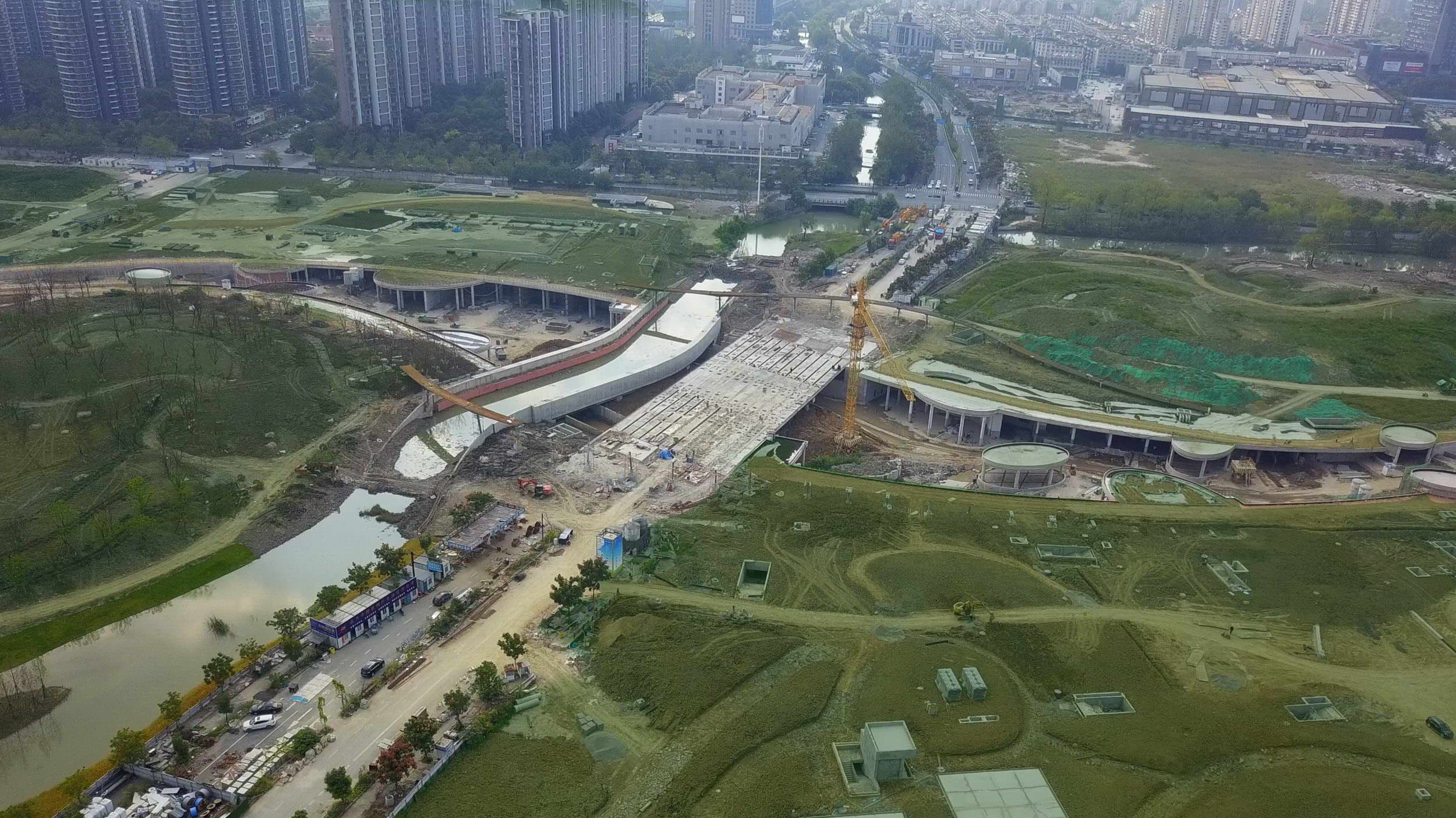
村谷购物中心和零土场地设计
Archi-Tectonics将这个位于繁华摩天大楼区的综合体构想为一个生态村,融合了社会景观、社区建筑和地貌,并将其作为可持续发展的基础设施,如人造自然保护区和水道。通过与城市现有结构的融合,生态村将街道的活动延伸到景观中,并充当 "城市海绵":收集、过滤和再利用雨水的绿肺。
Village Valley Mall and Zero Earth Site Design
Archi-Tectonics conceived the complex—which is set in a bustling skyscraper district—as an eco-village, a blend of social landscapes, community buildings, and landforms that double as sustainability infrastructure like man-made nature reserves and waterways. By integrating with the city’s existing fabric, the eco-village extends the activity of the streets into the landscape and acts as an ‘urban sponge’: a green lung that collects, filters, and re-uses storm-water runoff.
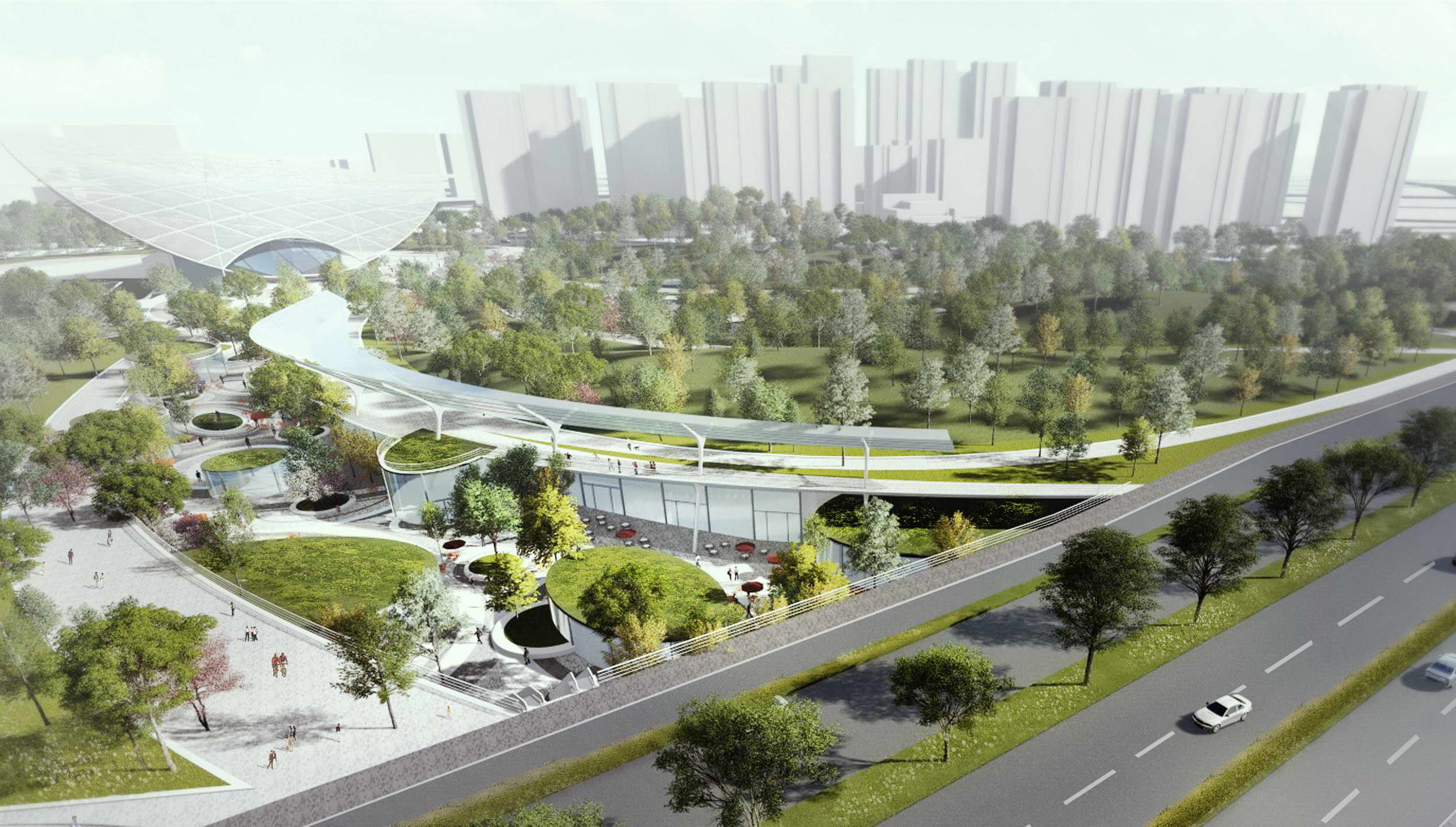
设计将两个体育场放在一英里长的线性场地的两端,并用一条下沉到地面的长廊连接起来。挖掘出长廊,使得周围的公园可以塑造成连绵起伏的山丘和湿地景观,而不需要带来额外的土壤,坚持 "零土 "策略,将建设对环境的影响降到最低。其中几座新山丘具有自然保护区的功能,促进生物多样性和生态保护。
The design places the two stadiums at either end of the mile-long linear site and connects them with a promenade sunken below grade. Digging out the promenade makes it possible to shape the surrounding park into a landscape of rolling hills and wetlands without bringing in additional soil, adhering to a ‘zero-earth’ strategy to minimizes the environmental impact of construction. Several of the new hills function as nature reserves, promoting biodiversity and ecological conservation.
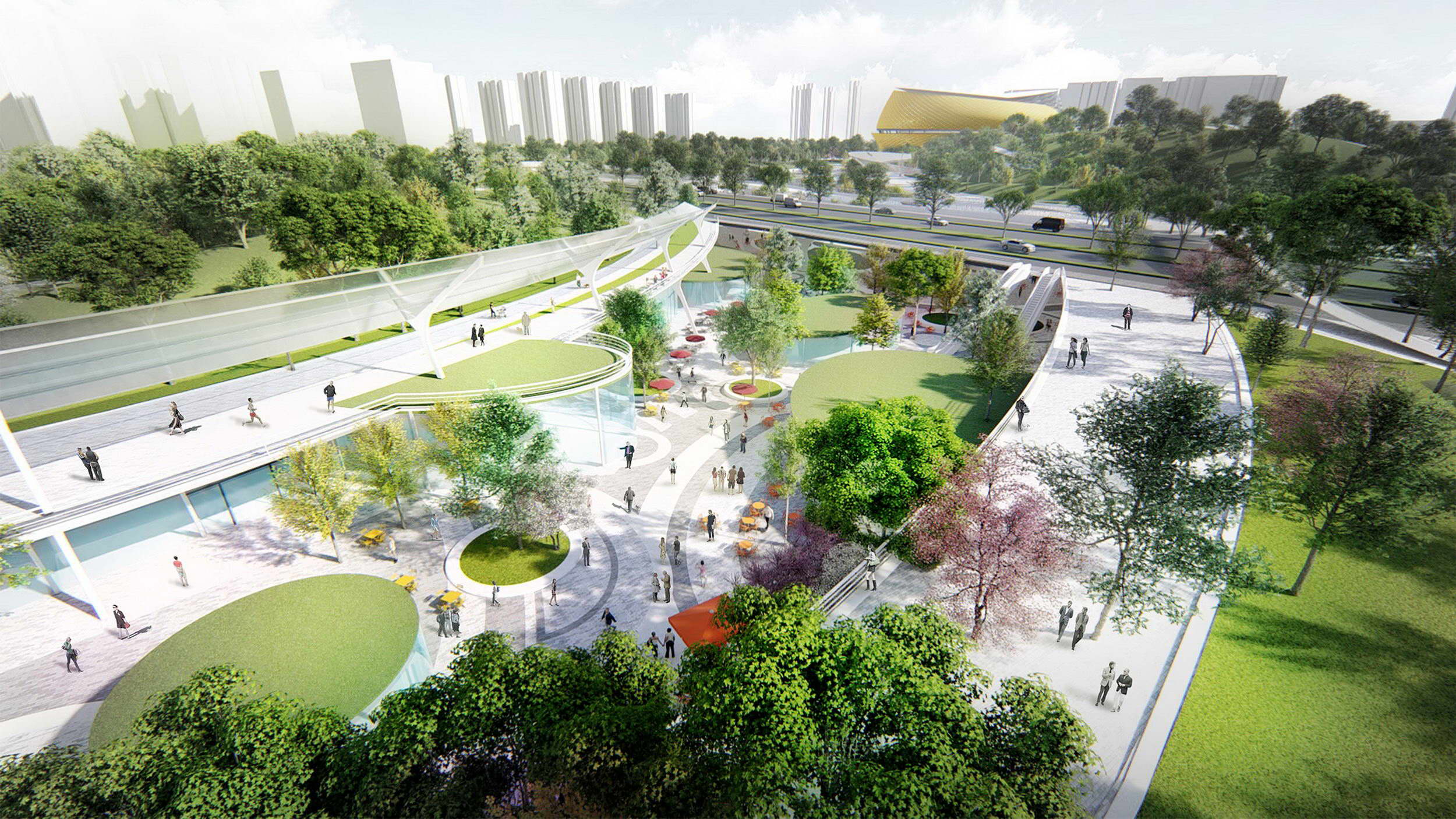
长廊本身被称为 "村谷商城",从现有的道路下穿过,形成整个场地的人行连接,两旁有商店、餐厅、咖啡馆、小卖部和户外聚会区,定位为生态村的社会核心。可持续发展的措施被纳入整个山谷:商店亭子的顶部是绿色屋顶,定制设计的太阳能之翼为户外聚会场所提供遮阳,同时为公园发电,而透水路面则最大限度地减少了雨水径流。
The promenade itself, called Village Valley Mall, passes under an existing roadway to create pedestrian connectivity across the site and is lined with shops, restaurants, cafes, kiosks, and outdoor gathering areas, positioning it as the social core of the eco-village. Sustainability measures are incorporated throughout the valley: store pavilions are topped with green roofs, custom-designed Solar Wings shade outdoor gathering spaces while generating electricity for the park, and permeable pavement minimizes storm-water runoff.

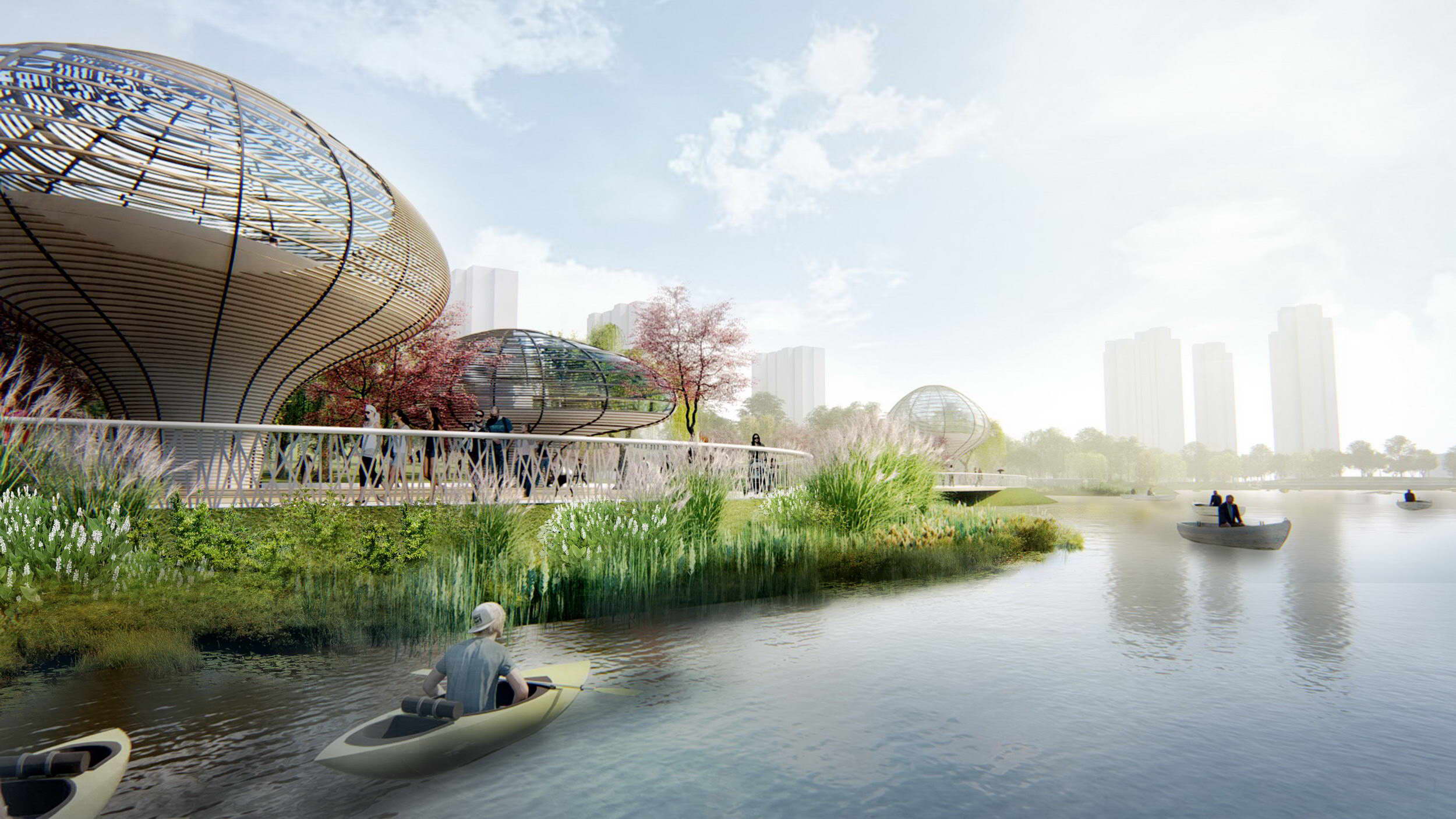
乒乓球馆
该建筑群的建筑中心是365,000平方英尺的乒乓球馆,可容纳5000名客人。体育场的设计灵感来自于 "琮",这是一种与杭州地区有关的中国古代玉石制品,其形状是一个带圆孔的方管。以这个几何形状为出发点,Archi-Tectonics开始了参数化的设计过程,以确定一个最佳的形状,使体育场能够有效地从一个体育场馆转化为一个表演场地。最终的设计创造了一个竹子包覆的碗,融合了竞技场和露天剧场的座位方案,使体育场能够将体育赛事首选的中央观赛布局调整为非对称的、舞台中心的表演配置。次要的项目空间,如餐厅、VIP休息室和零售区被纳入整个建筑中,创造了一个多层次和动态的环境--不仅仅是一个观看体育或表演的容器,而是一个设备齐全的活动和娱乐场所。
Table Tennis Stadium
The architectural centerpiece of the complex is the 365,000-square-foot Table Tennis Stadium with seating for 5,000 guests. The design of the stadium is inspired by the Cong, an ancient Chinese jade-stone artifact associated with the Hangzhou region that takes the shape of a square tube with a circular bore. Using this geometry as a starting point, Archi-Tectonics embarked on a parametric design process to determine an optimal shape allowing the stadium to efficiently convert from a sports arena to a performance venue. The final design creates a bamboo clad bowl that merges arena and amphitheater seating schemes, allowing the stadium to adapt the central viewing layout preferred for sporting events into an asymmetric, stage-centered configuration for performances. Secondary program spaces like restaurants, VIP lounges, and retail areas are incorporated throughout the building, creating a layered and dynamic environment that—more than just a container for viewing sports or performances—serves as a fully-equipped events and entertainment destination.
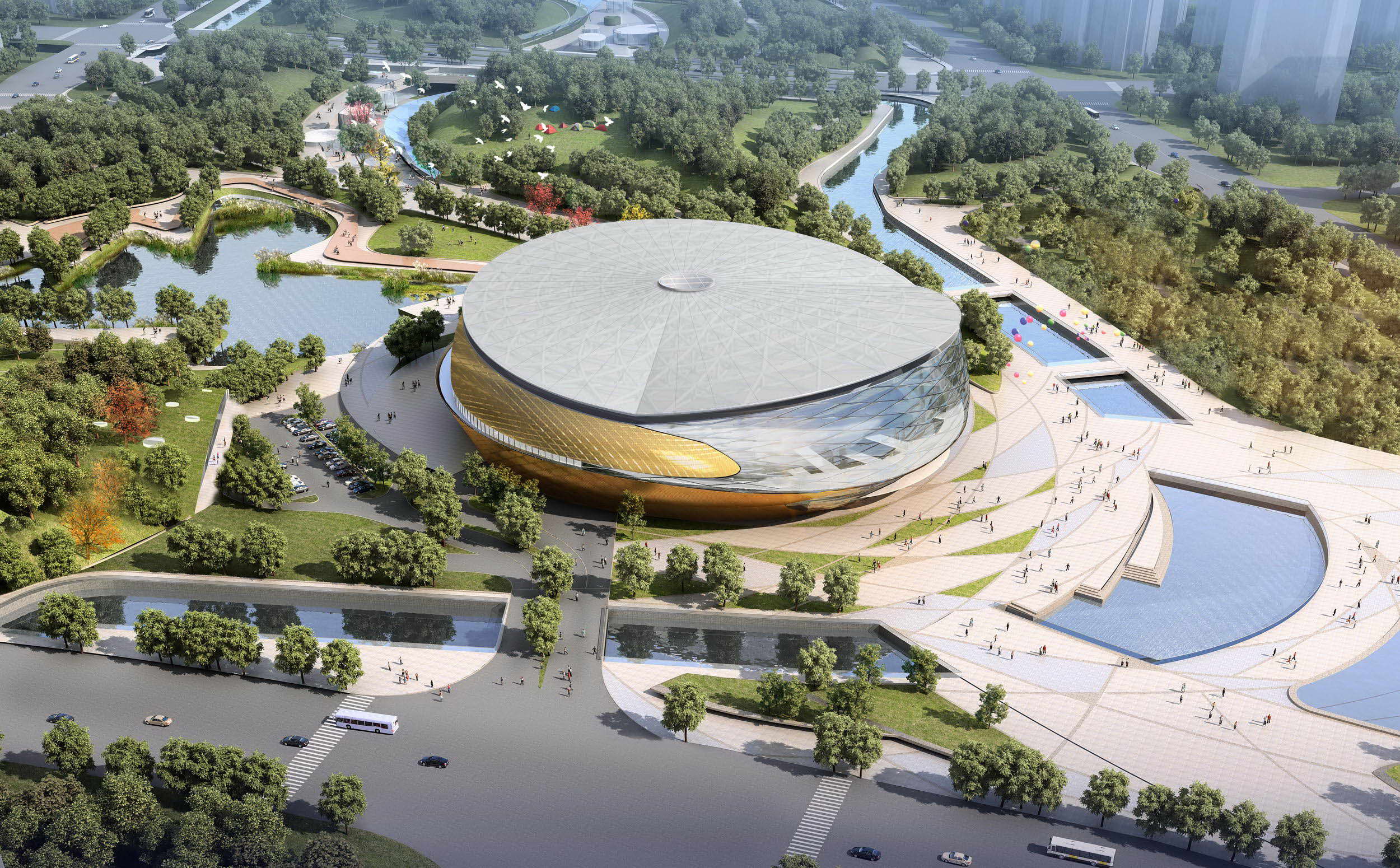
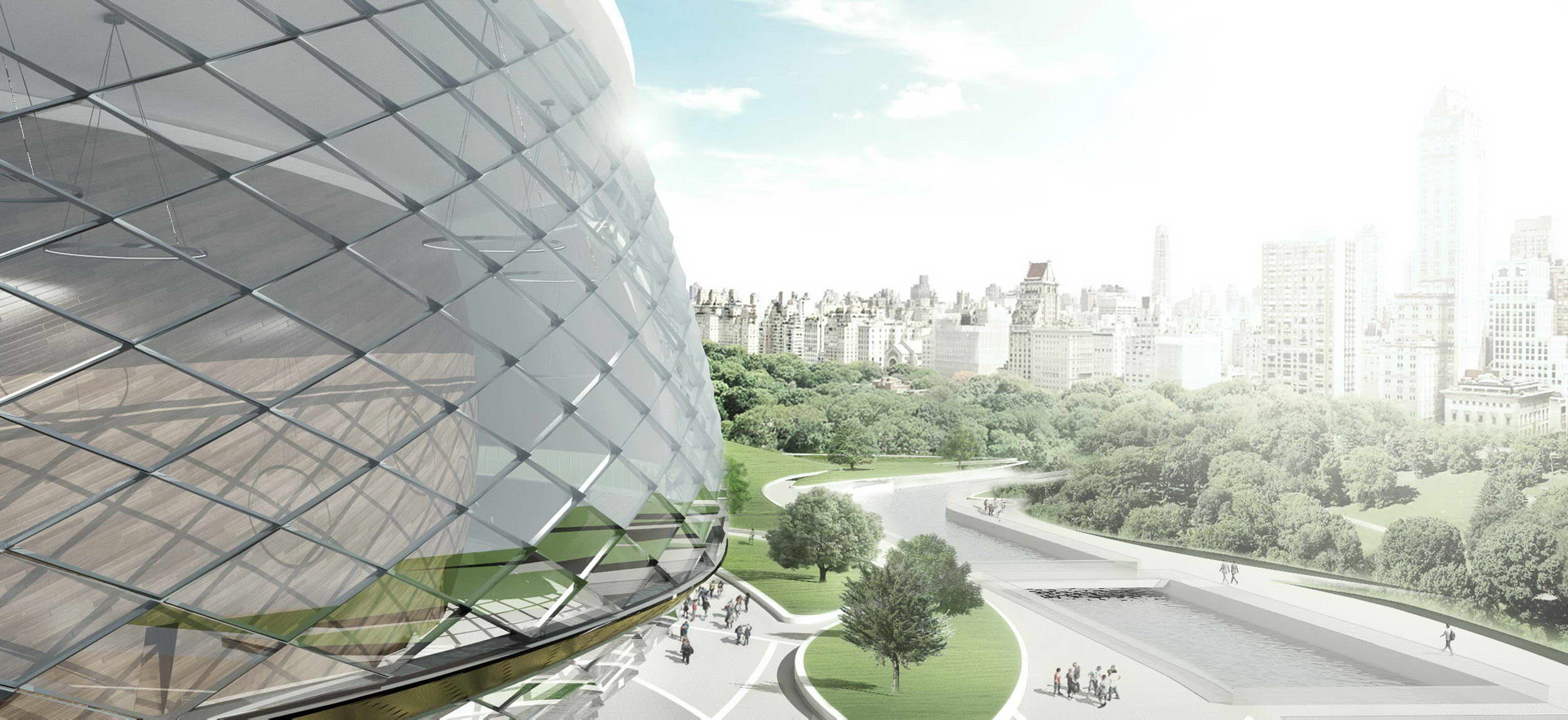
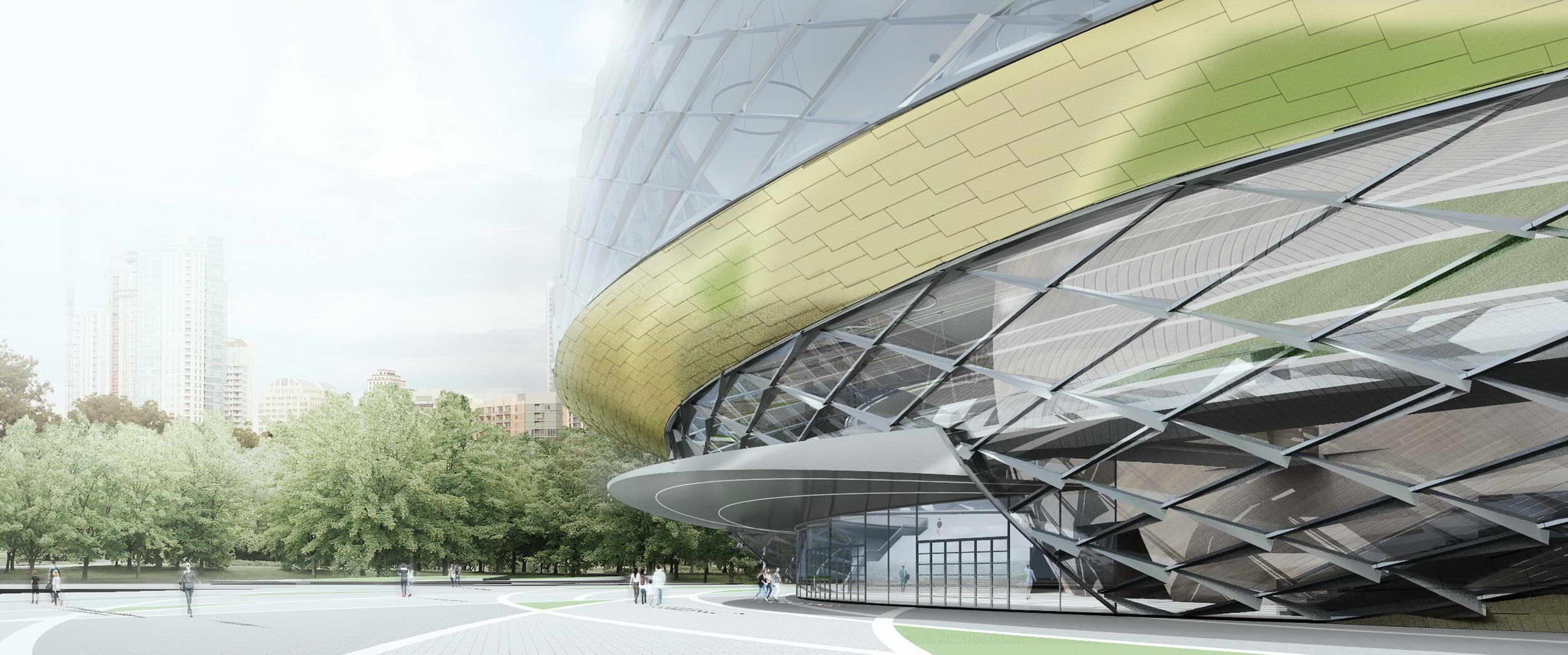
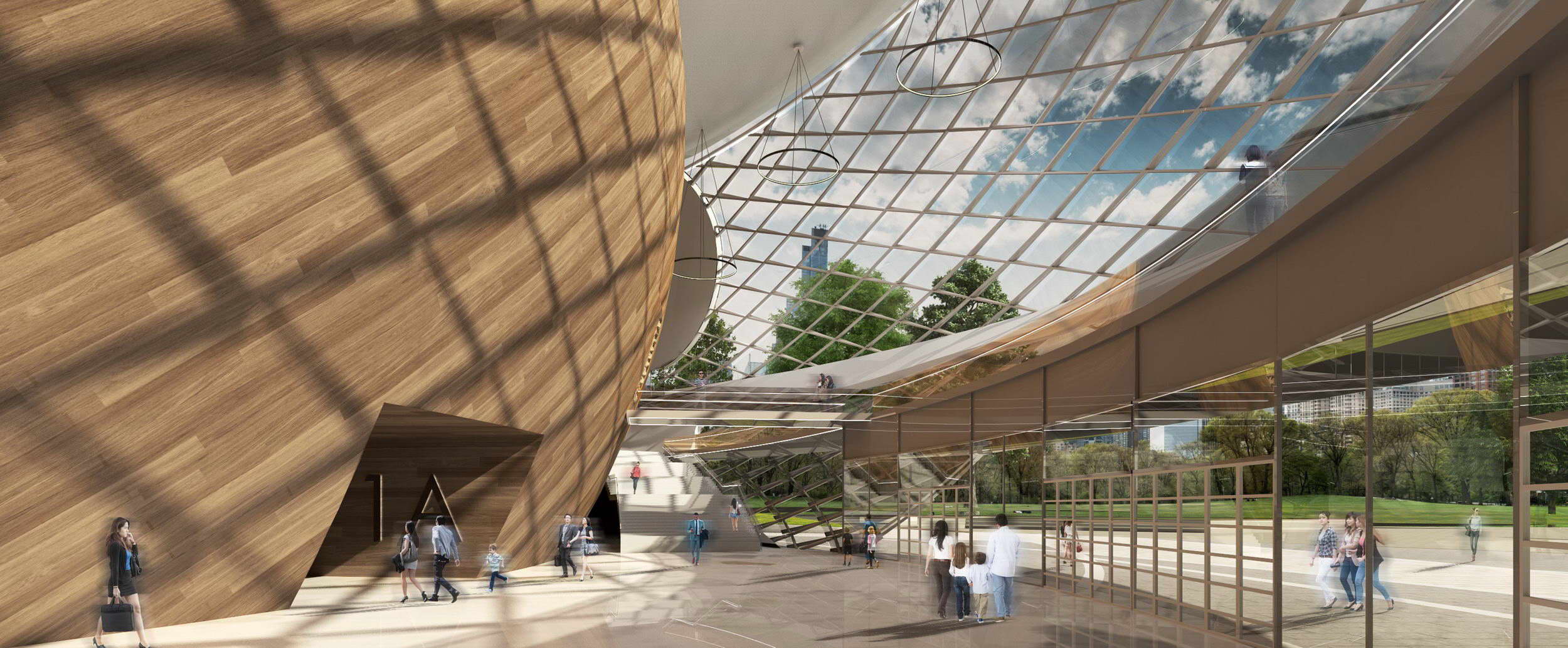
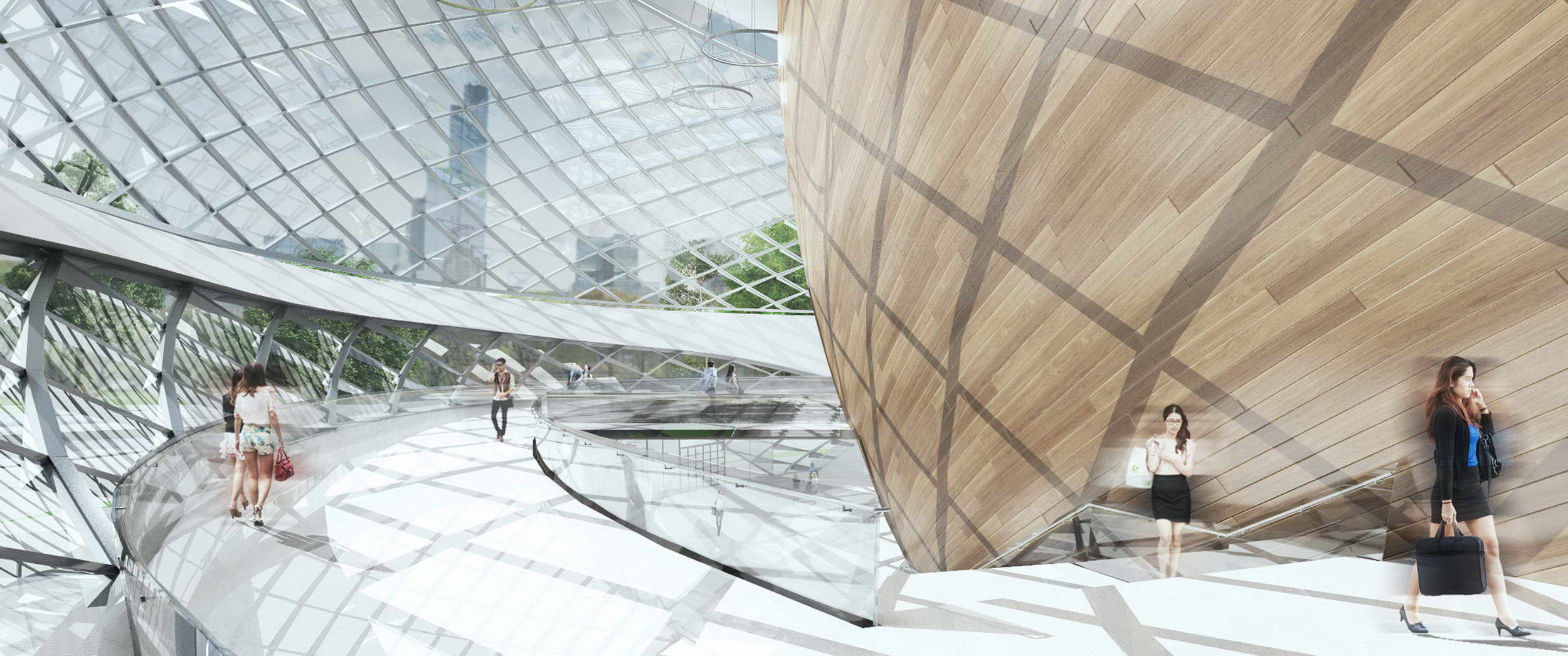
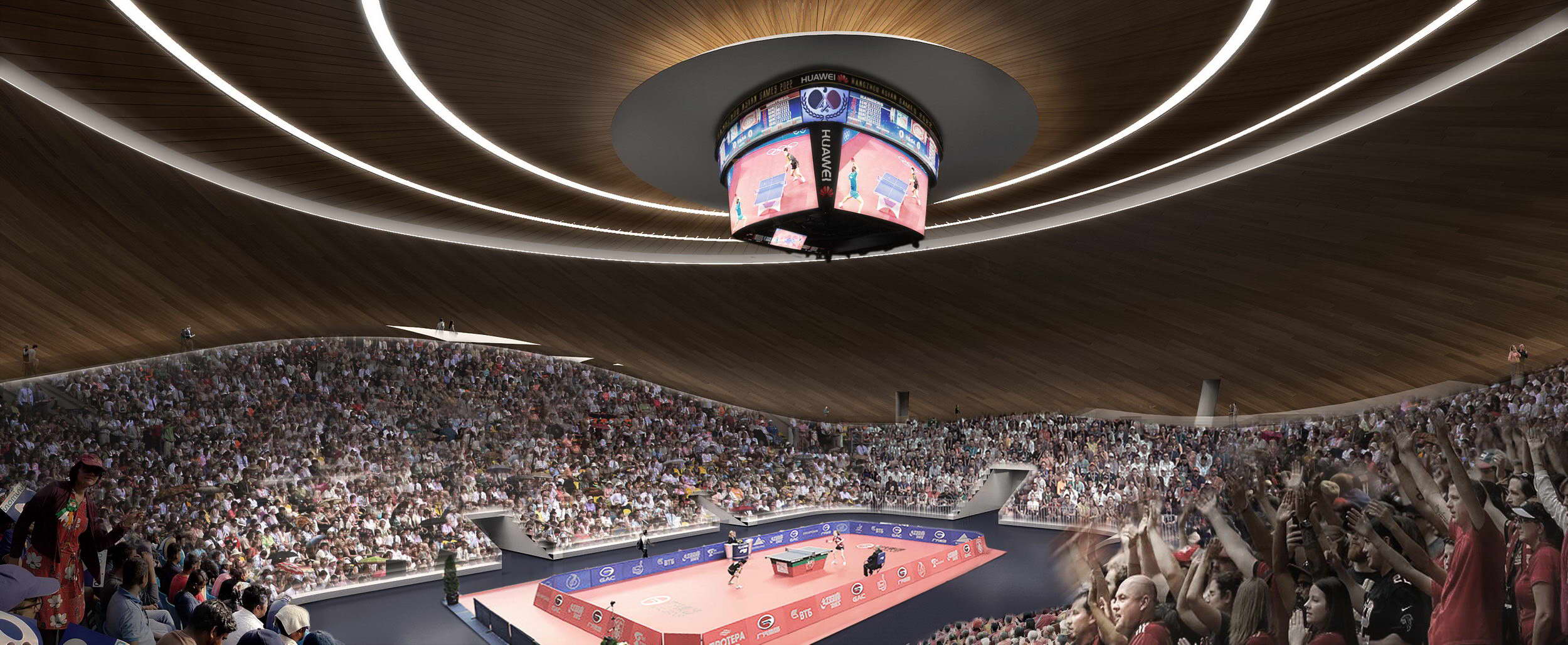
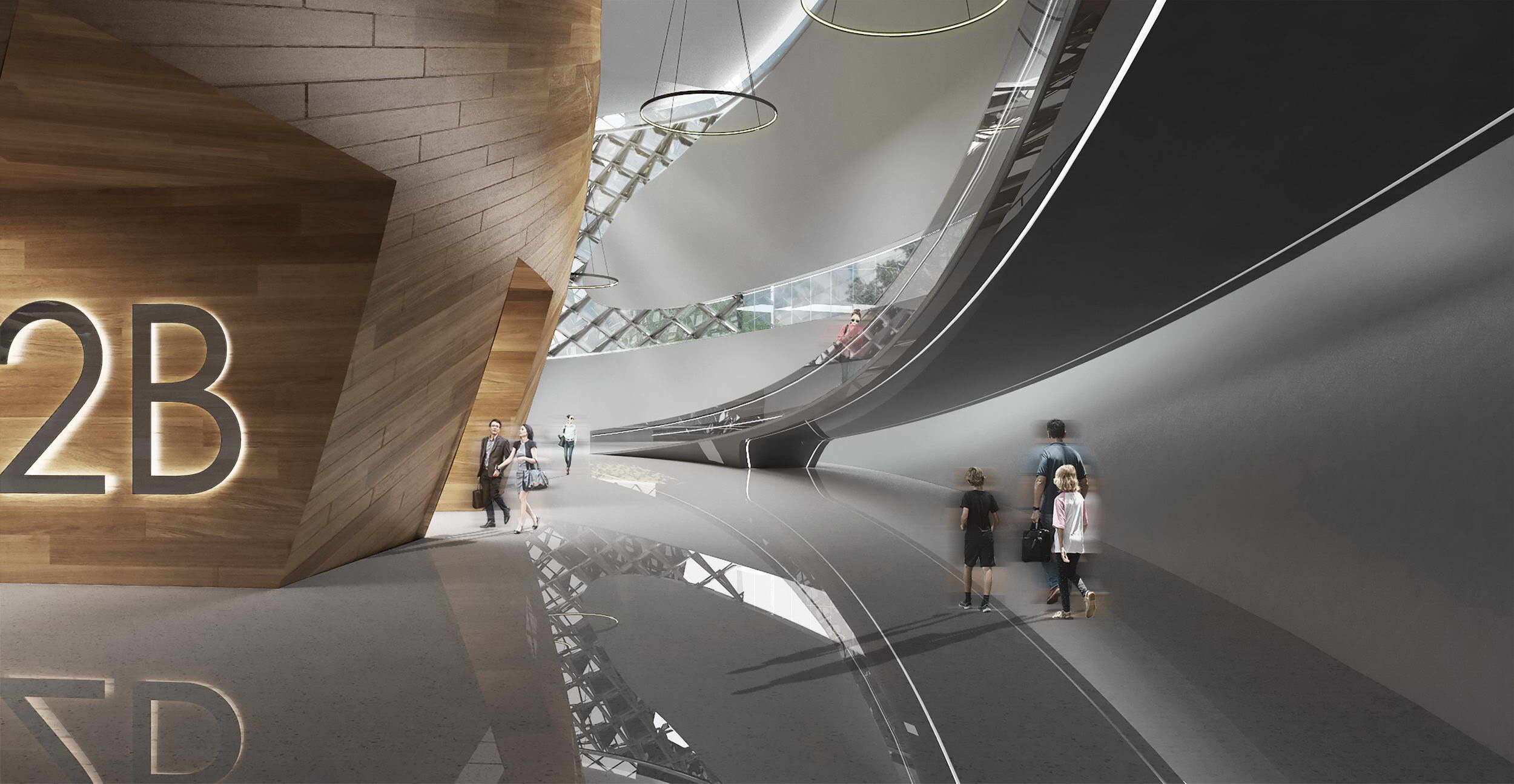
体育场的特点是斜对角立面,这是一种创新的方法,将横向和重力承载阻力结合成一个对角网格系统,消除了柱的需要。弯曲的立面包围了一个宽阔的、光线充足的大厅,它环绕着整个建筑,容纳大量进出的人群。建筑构造学会运用BIM技术,与结构工程师和当地制造商合作,测试不同的模块尺寸如何影响成本、可施工性和立面的视觉效果。最终的设计——使用10英寸x 20米的直玻璃窗格来达到弯曲的效果——优化了材料效率和施工方便性。
The stadium features a diagrid facade, an innovative approach combining lateral- and gravity-load bearing resistances into a single diagonal grid system that eliminates the need for columns. The curving facade encloses a sweeping, light-filled lobby that wraps around the entirety of the building and accommodates large crowds entering and leaving. Archi-Tectonics used BIM in coordination with the structural engineer and local fabricator to test how different module dimensions impacted the cost, constructability, and visual effect of the facade. The final design—which uses 10" x 20m straight glass panes to achieve the curving effect—is optimized for materials efficiency and ease-of-construction.
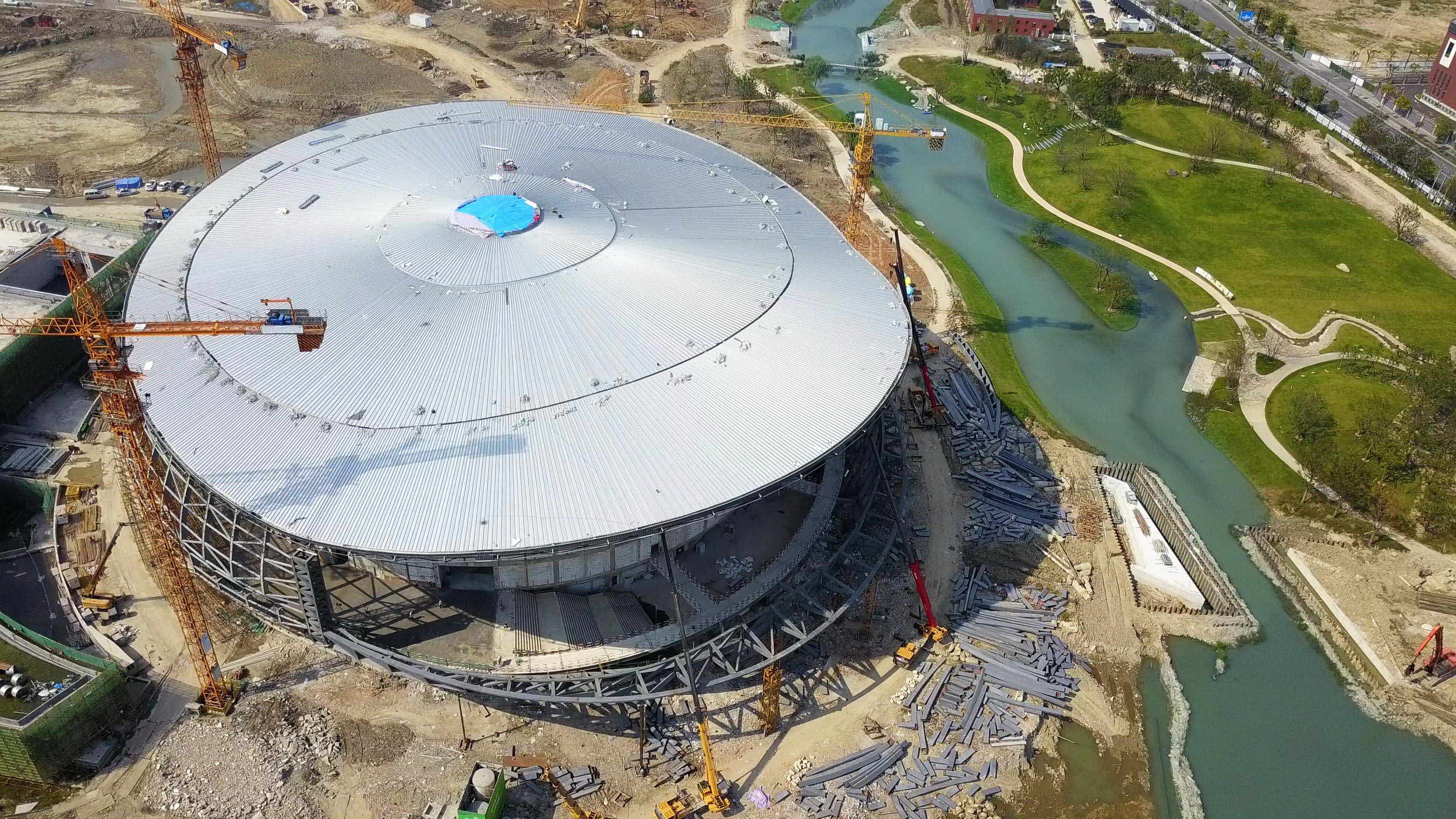

曲棍球场
在公园的另一端,有5,000个座位的露天曲棍球场以其半透明的翼型屋顶来定义。受传统油纸竹伞的结构和材料的启发,翼型屋顶为看台、场地和入口广场提供了遮挡,同时为公园引入了一个雕塑元素。在与结构工程师Thornton Tomasetti的密切合作下,我们对翼型屋顶进行了多次原型设计和测试,最终确定了一种超轻结构,使其410英尺的自由跨度成为可能。
Field Hockey Stadium
At the opposite end of the park, the 5,000-seat open-air Field Hockey Stadium is defined by its translucent wing roof. Inspired by the structure and materiality of the traditional oil-paper-and-bamboo umbrella, the wing roof shades the stands, field, and entrance plaza while introducing a sculptural element in the park. Working closely with structural engineer Thornton Tomasetti, we prototyped and tested several iterations of the wing roof, arriving at an ultra-lightweight structure that makes possible its 410-foot free span.
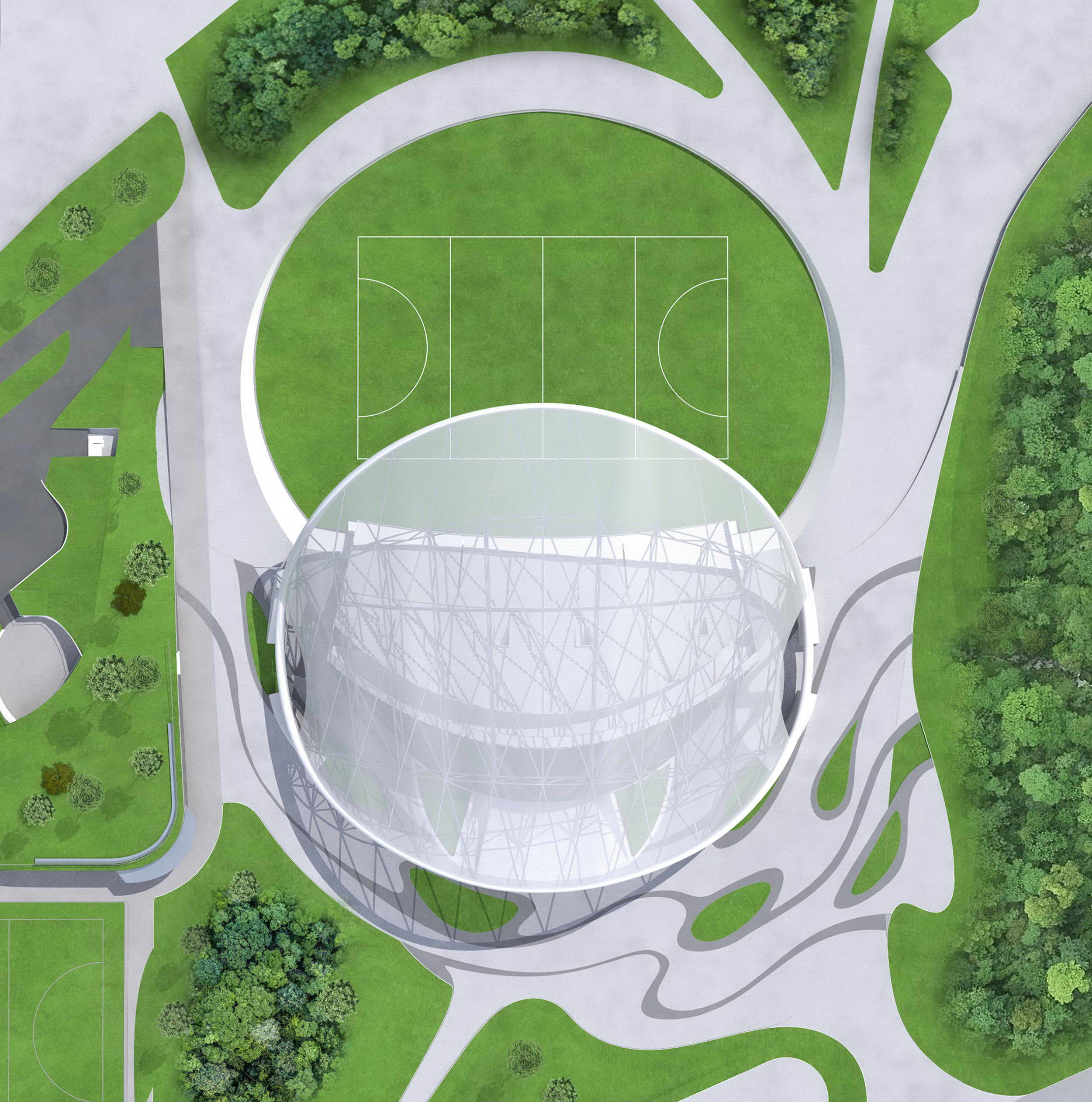
运动场本身被设置在一个凹陷的椭圆形草地上,作为一个景观特色,并可在奥运会结束后转换为举办户外活动,包括音乐会、夜市和社区聚会。大厅由弧形玻璃幕墙围合,并由工程硬木和钢材支撑,形成光与影的戏剧性交错。这些高科技的形式和材料被更多的传统饰面所柔化,如竹子包覆的内墙,使室内体验更加温馨。
The playing field itself is set into a recessed oval-shaped grass plain that doubles as a landscape feature and can be converted to host outdoor events after the Games end, including concerts, night markets, and community gatherings. A curving glass facade encloses the lobby, supported by engineered hardwood and steel that creates a dramatic interplay of light and shadow. These high-tech forms and materials are softened by more traditional finishes—like the bamboo-clad interior walls—that make for an inviting interior experience.
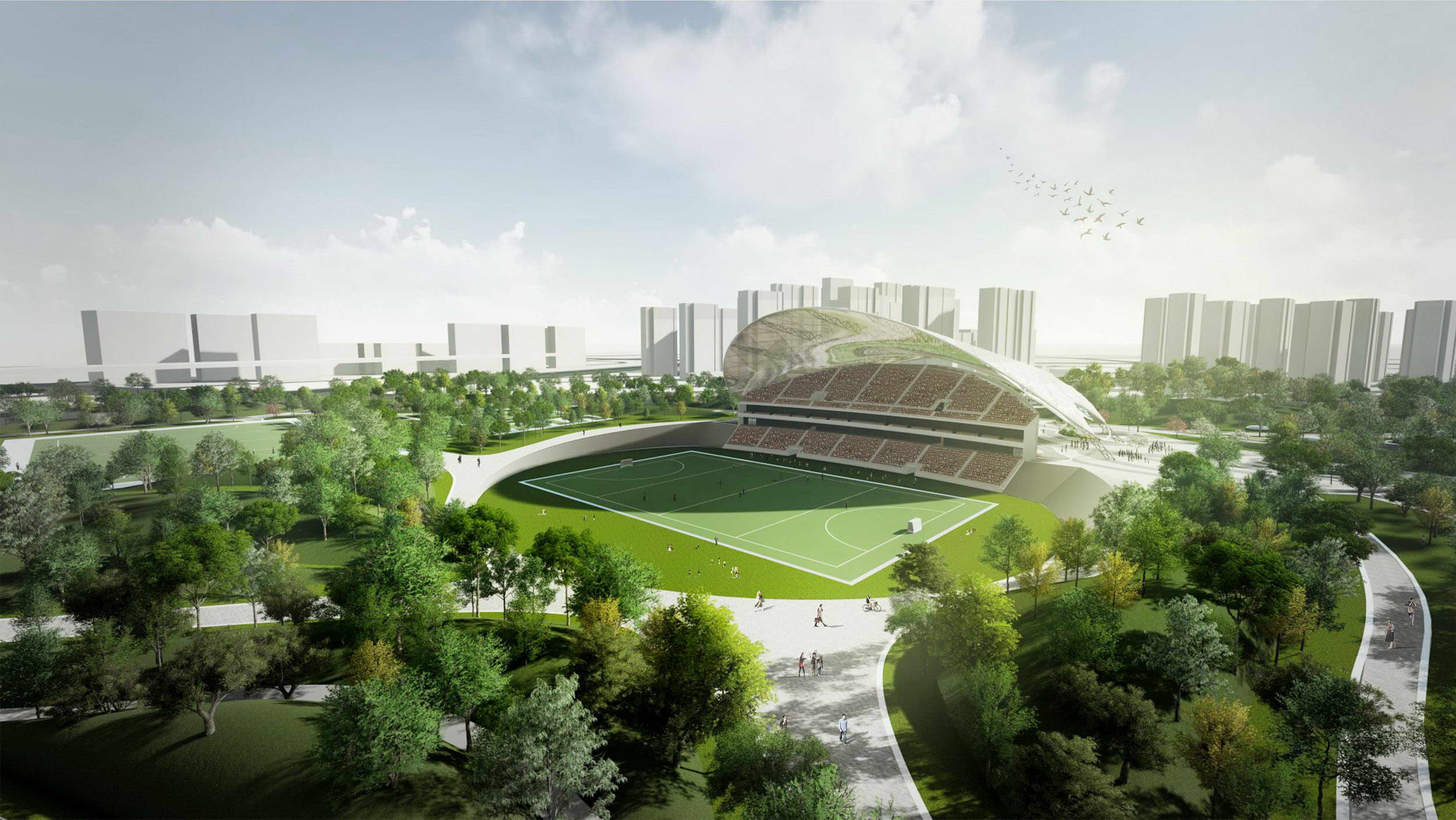
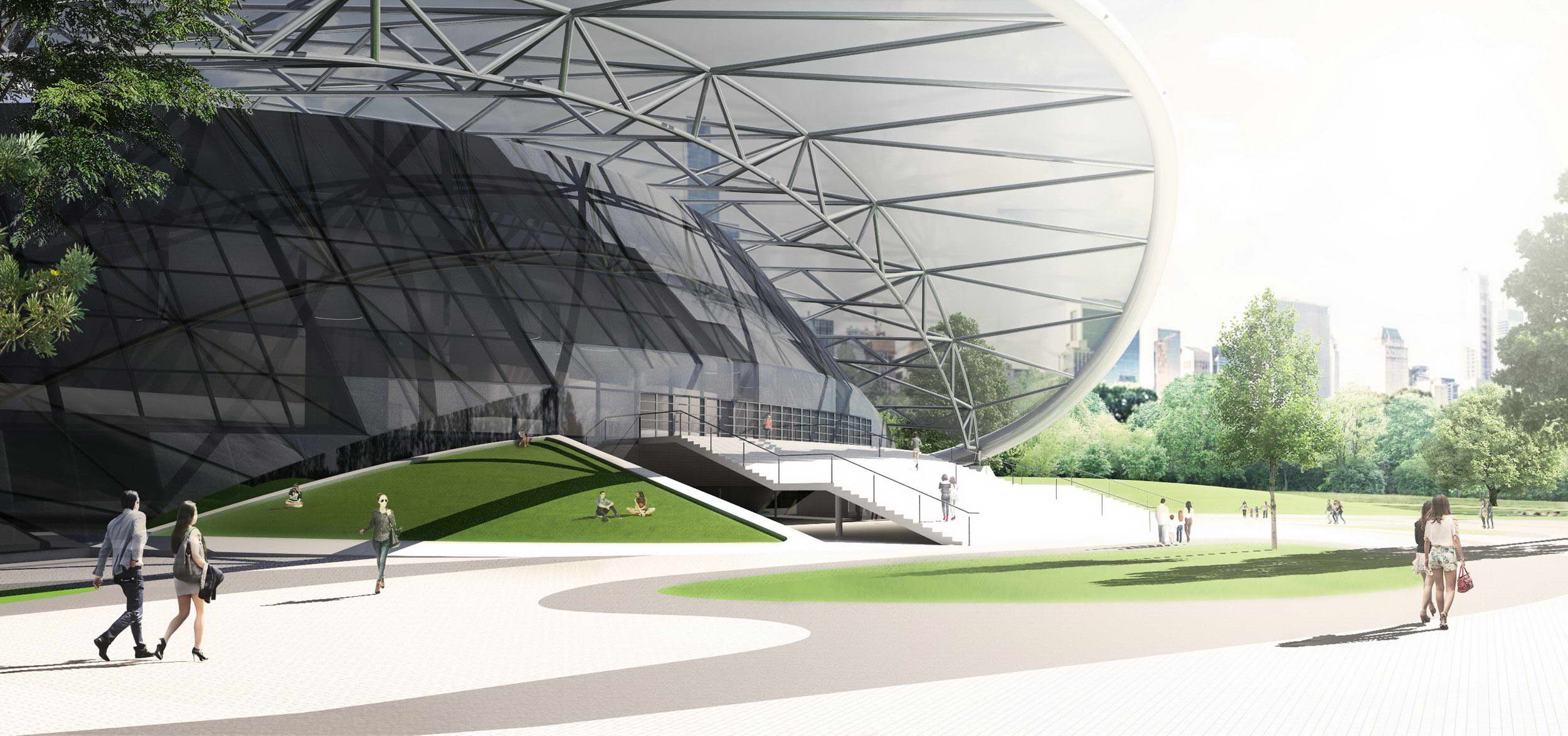
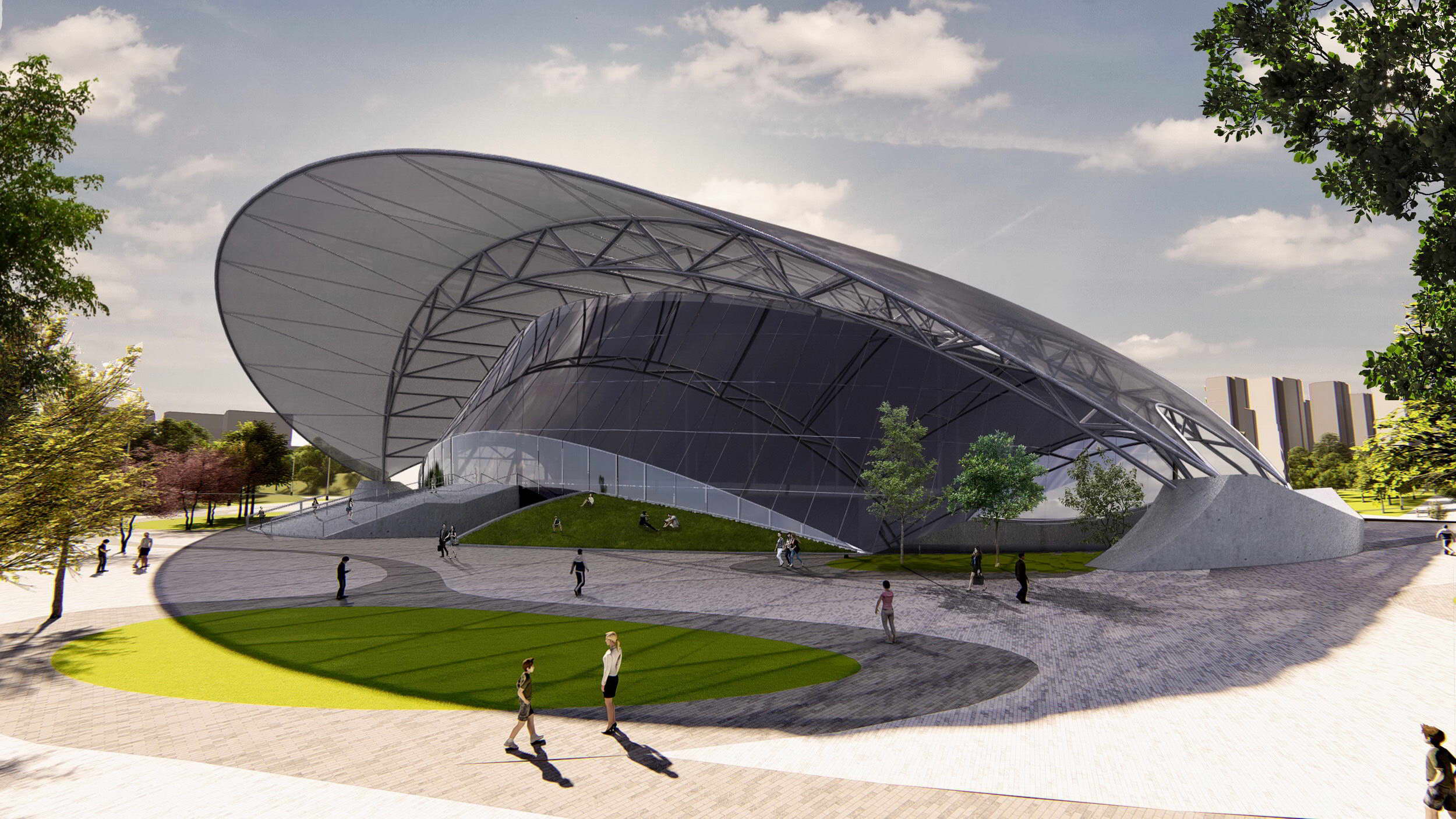
Project:Hangzhou Asian Games Park
Design firm:Archi-Tectonics + !melk
Year: Competition won: 2018, Construction phase: 2020, Substantial completion: 2021
Location: Hangzhou, China
Client: Government: Gongshu District City Village Reconstruction Department
Project Type: 16-acre eco park with 2 stadiums, shopping mall, visitors and fitness centers, and 2 parking garages for the 2022 Hangzhou Asian Games
Size: 46.7 hectare park, 35,000 m2 Table Tennis stadium (5000 seats), 15,000 m2 Field Hockey stadium (5000 seats), 29,000 m2 commercial mall, 23,00 m2 fitness center, and 68,000 m2 underground parking, all with green roofs and natural ventilation
Design Team: Principal in charge: Winka Dubbeldam, Assoc. AIA | Project Leader: Justin Korhammer | Main Designers: Paul Starosta, Max Boerman | Archi-Tectonics Team: Dongliang Li, Maud Fonteyne, Soyeon Cha, Boden Davies, Alex Bahr, Dan Rothbart, Bowen Qin
Consultants:
Structural Engineers: Thornton Tomasetti
Transport Planning: Mobility in Chain, Italy
Mechanical Engineers: Ryan Soames Engineering
Collaborators: !melk Landscape Design | UAD Research group, Hangzhou, China
Renderings and Diagrams: Archi-Tectonics | MIC | !melk
Animation: !melk